Human Resource Management Practices at Unilever: A Report
VerifiedAdded on 2020/07/22
|16
|3876
|44
Report
AI Summary
This report provides an in-depth analysis of Human Resource Management (HRM) practices, focusing on their application within Unilever. The report begins by outlining the purpose and functions of HRM, particularly in workforce planning, highlighting how Unilever manages its large workforce through recruitment, selection, and employee relations. It examines both hard and soft HRM approaches. The report then explores different recruitment sources, comparing the advantages and disadvantages of internal and external hiring strategies. Furthermore, the report details specific HRM practices, such as performance appraisal and compensation and benefits, emphasizing their impact on employee performance and motivation. Finally, it discusses the effectiveness of these practices, including flexible working hours and training and development programs, in fostering a positive work environment and retaining a skilled workforce within Unilever. The report is a comprehensive overview of HRM in a global context, demonstrating how these practices contribute to the overall success of a major multinational corporation.
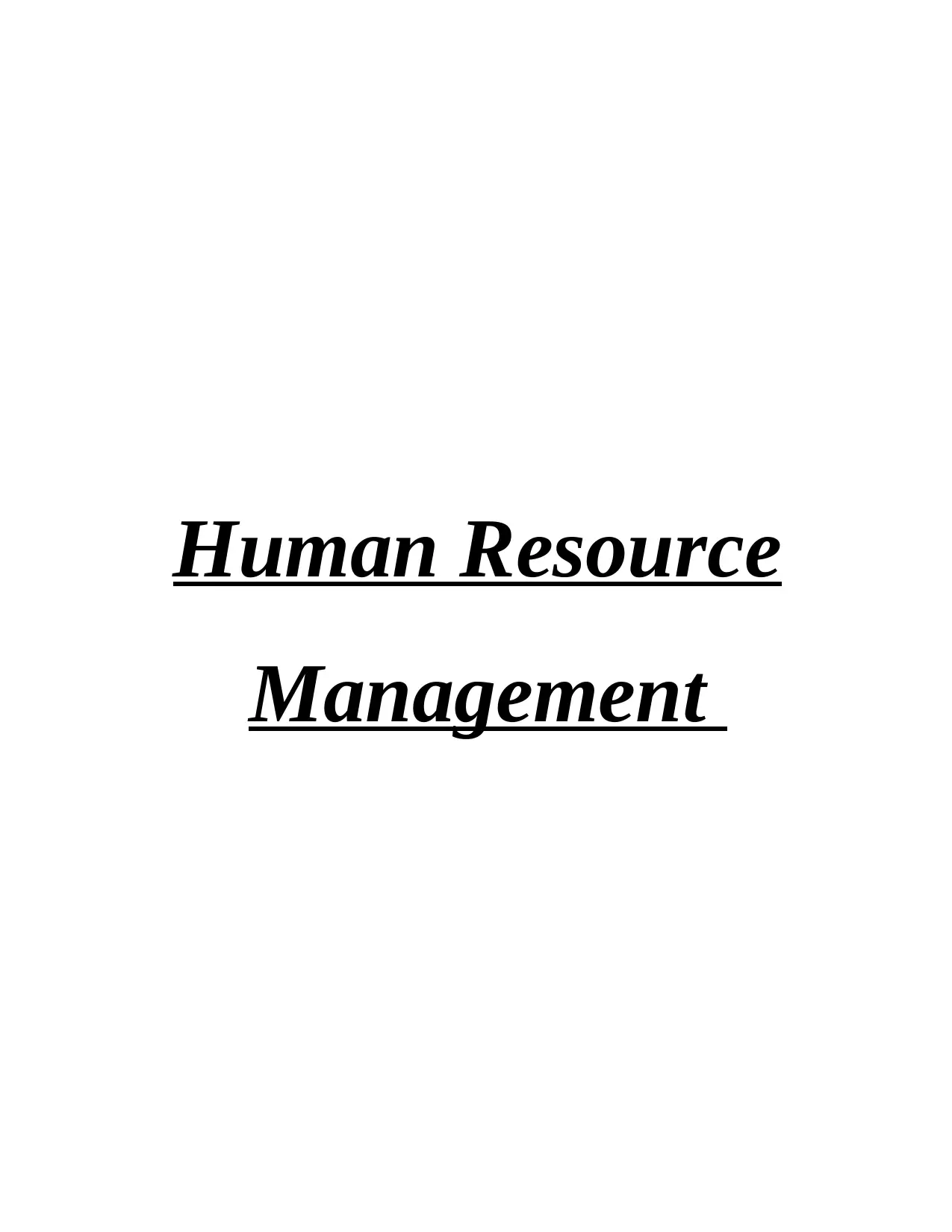
Human Resource
Management
Management
Paraphrase This Document
Need a fresh take? Get an instant paraphrase of this document with our AI Paraphraser
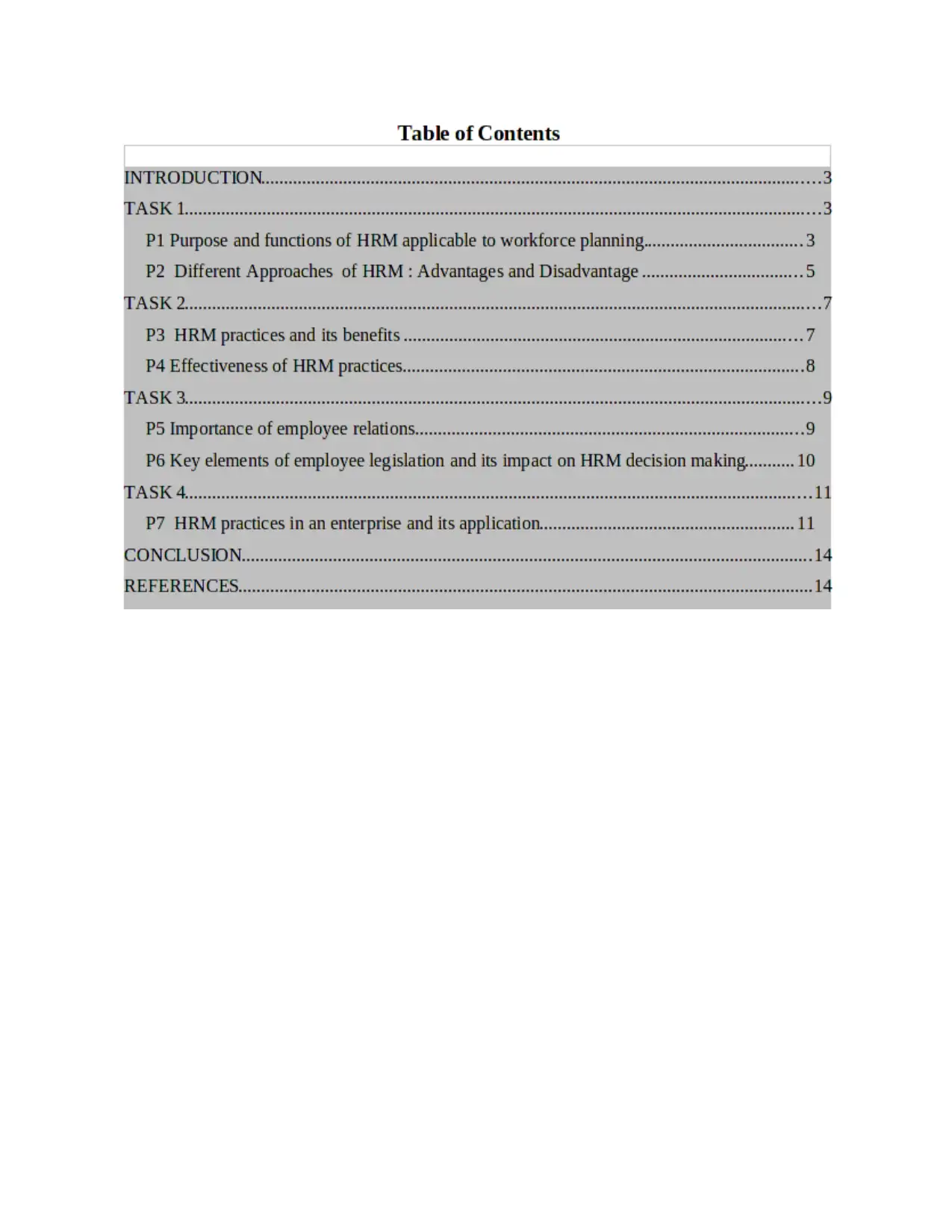
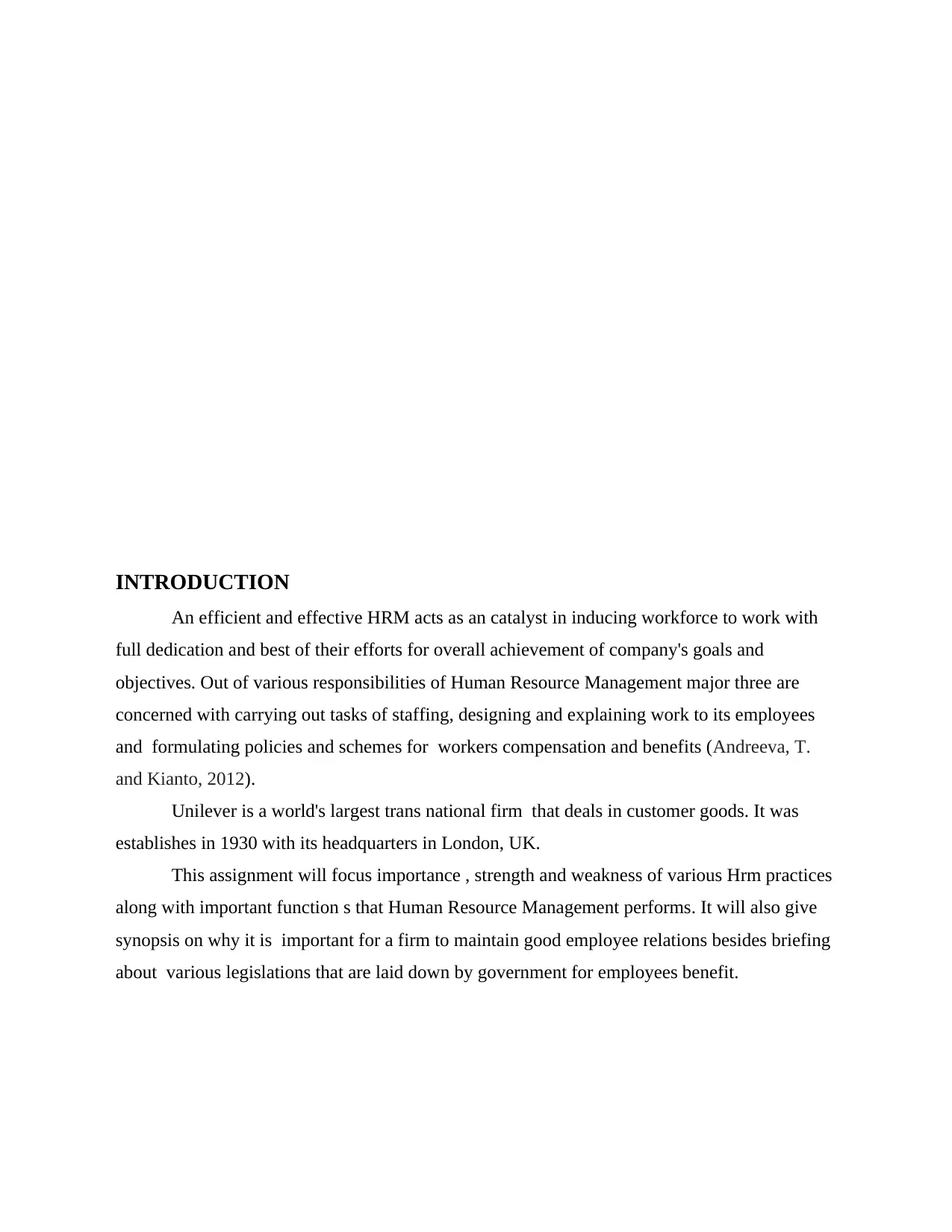
INTRODUCTION
An efficient and effective HRM acts as an catalyst in inducing workforce to work with
full dedication and best of their efforts for overall achievement of company's goals and
objectives. Out of various responsibilities of Human Resource Management major three are
concerned with carrying out tasks of staffing, designing and explaining work to its employees
and formulating policies and schemes for workers compensation and benefits (Andreeva, T.
and Kianto, 2012).
Unilever is a world's largest trans national firm that deals in customer goods. It was
establishes in 1930 with its headquarters in London, UK.
This assignment will focus importance , strength and weakness of various Hrm practices
along with important function s that Human Resource Management performs. It will also give
synopsis on why it is important for a firm to maintain good employee relations besides briefing
about various legislations that are laid down by government for employees benefit.
An efficient and effective HRM acts as an catalyst in inducing workforce to work with
full dedication and best of their efforts for overall achievement of company's goals and
objectives. Out of various responsibilities of Human Resource Management major three are
concerned with carrying out tasks of staffing, designing and explaining work to its employees
and formulating policies and schemes for workers compensation and benefits (Andreeva, T.
and Kianto, 2012).
Unilever is a world's largest trans national firm that deals in customer goods. It was
establishes in 1930 with its headquarters in London, UK.
This assignment will focus importance , strength and weakness of various Hrm practices
along with important function s that Human Resource Management performs. It will also give
synopsis on why it is important for a firm to maintain good employee relations besides briefing
about various legislations that are laid down by government for employees benefit.
⊘ This is a preview!⊘
Do you want full access?
Subscribe today to unlock all pages.

Trusted by 1+ million students worldwide
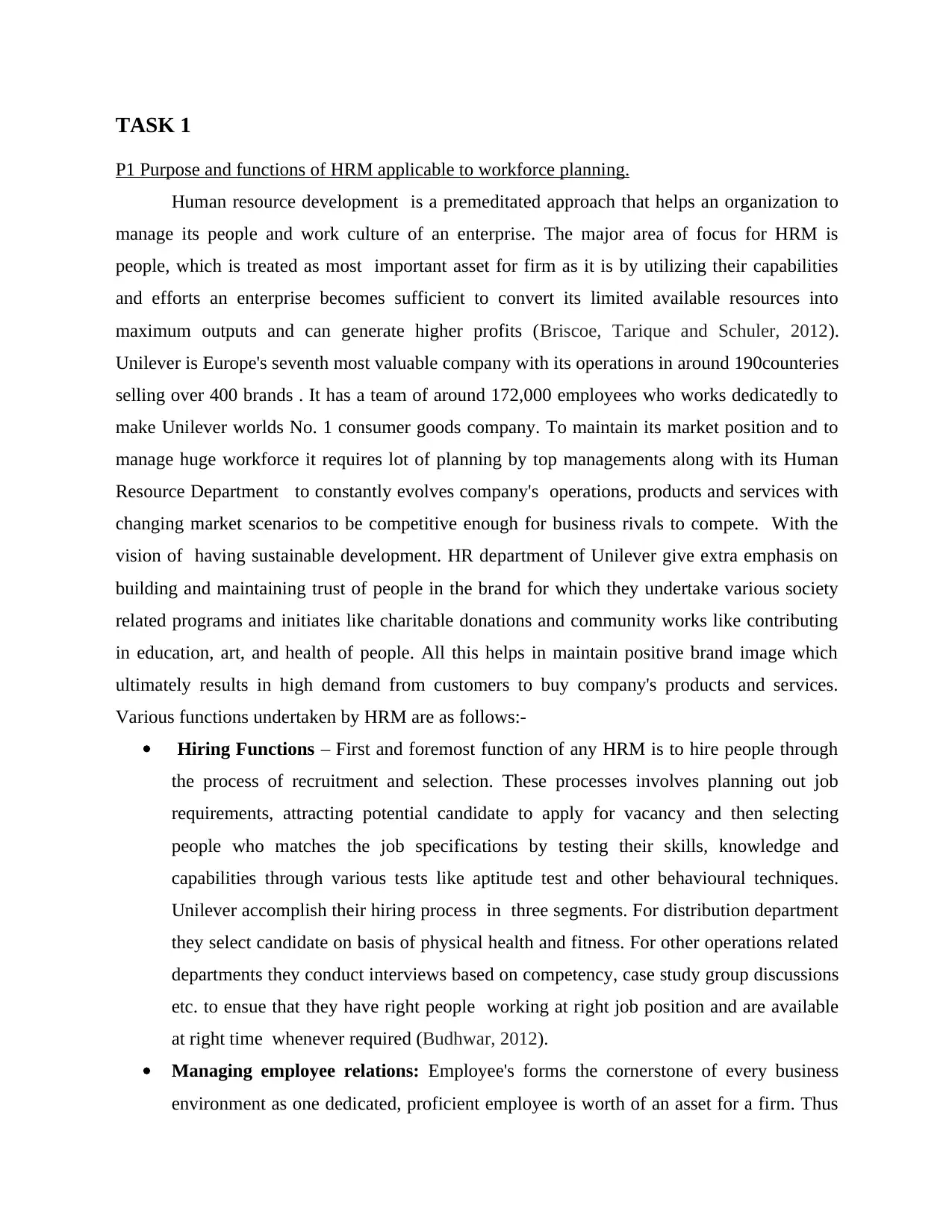
TASK 1
P1 Purpose and functions of HRM applicable to workforce planning.
Human resource development is a premeditated approach that helps an organization to
manage its people and work culture of an enterprise. The major area of focus for HRM is
people, which is treated as most important asset for firm as it is by utilizing their capabilities
and efforts an enterprise becomes sufficient to convert its limited available resources into
maximum outputs and can generate higher profits (Briscoe, Tarique and Schuler, 2012).
Unilever is Europe's seventh most valuable company with its operations in around 190counteries
selling over 400 brands . It has a team of around 172,000 employees who works dedicatedly to
make Unilever worlds No. 1 consumer goods company. To maintain its market position and to
manage huge workforce it requires lot of planning by top managements along with its Human
Resource Department to constantly evolves company's operations, products and services with
changing market scenarios to be competitive enough for business rivals to compete. With the
vision of having sustainable development. HR department of Unilever give extra emphasis on
building and maintaining trust of people in the brand for which they undertake various society
related programs and initiates like charitable donations and community works like contributing
in education, art, and health of people. All this helps in maintain positive brand image which
ultimately results in high demand from customers to buy company's products and services.
Various functions undertaken by HRM are as follows:-
Hiring Functions – First and foremost function of any HRM is to hire people through
the process of recruitment and selection. These processes involves planning out job
requirements, attracting potential candidate to apply for vacancy and then selecting
people who matches the job specifications by testing their skills, knowledge and
capabilities through various tests like aptitude test and other behavioural techniques.
Unilever accomplish their hiring process in three segments. For distribution department
they select candidate on basis of physical health and fitness. For other operations related
departments they conduct interviews based on competency, case study group discussions
etc. to ensue that they have right people working at right job position and are available
at right time whenever required (Budhwar, 2012).
Managing employee relations: Employee's forms the cornerstone of every business
environment as one dedicated, proficient employee is worth of an asset for a firm. Thus
P1 Purpose and functions of HRM applicable to workforce planning.
Human resource development is a premeditated approach that helps an organization to
manage its people and work culture of an enterprise. The major area of focus for HRM is
people, which is treated as most important asset for firm as it is by utilizing their capabilities
and efforts an enterprise becomes sufficient to convert its limited available resources into
maximum outputs and can generate higher profits (Briscoe, Tarique and Schuler, 2012).
Unilever is Europe's seventh most valuable company with its operations in around 190counteries
selling over 400 brands . It has a team of around 172,000 employees who works dedicatedly to
make Unilever worlds No. 1 consumer goods company. To maintain its market position and to
manage huge workforce it requires lot of planning by top managements along with its Human
Resource Department to constantly evolves company's operations, products and services with
changing market scenarios to be competitive enough for business rivals to compete. With the
vision of having sustainable development. HR department of Unilever give extra emphasis on
building and maintaining trust of people in the brand for which they undertake various society
related programs and initiates like charitable donations and community works like contributing
in education, art, and health of people. All this helps in maintain positive brand image which
ultimately results in high demand from customers to buy company's products and services.
Various functions undertaken by HRM are as follows:-
Hiring Functions – First and foremost function of any HRM is to hire people through
the process of recruitment and selection. These processes involves planning out job
requirements, attracting potential candidate to apply for vacancy and then selecting
people who matches the job specifications by testing their skills, knowledge and
capabilities through various tests like aptitude test and other behavioural techniques.
Unilever accomplish their hiring process in three segments. For distribution department
they select candidate on basis of physical health and fitness. For other operations related
departments they conduct interviews based on competency, case study group discussions
etc. to ensue that they have right people working at right job position and are available
at right time whenever required (Budhwar, 2012).
Managing employee relations: Employee's forms the cornerstone of every business
environment as one dedicated, proficient employee is worth of an asset for a firm. Thus
Paraphrase This Document
Need a fresh take? Get an instant paraphrase of this document with our AI Paraphraser
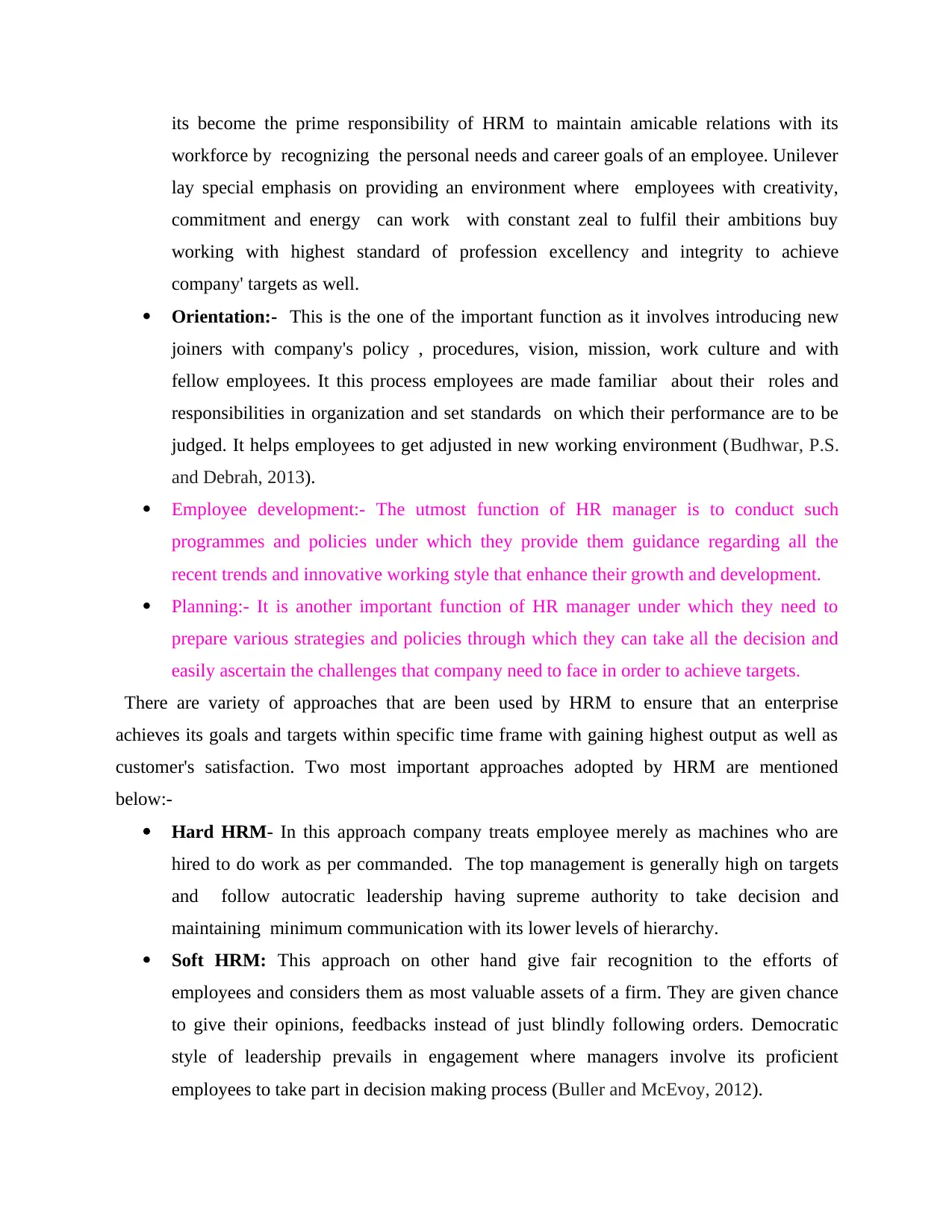
its become the prime responsibility of HRM to maintain amicable relations with its
workforce by recognizing the personal needs and career goals of an employee. Unilever
lay special emphasis on providing an environment where employees with creativity,
commitment and energy can work with constant zeal to fulfil their ambitions buy
working with highest standard of profession excellency and integrity to achieve
company' targets as well.
Orientation:- This is the one of the important function as it involves introducing new
joiners with company's policy , procedures, vision, mission, work culture and with
fellow employees. It this process employees are made familiar about their roles and
responsibilities in organization and set standards on which their performance are to be
judged. It helps employees to get adjusted in new working environment (Budhwar, P.S.
and Debrah, 2013).
Employee development:- The utmost function of HR manager is to conduct such
programmes and policies under which they provide them guidance regarding all the
recent trends and innovative working style that enhance their growth and development.
Planning:- It is another important function of HR manager under which they need to
prepare various strategies and policies through which they can take all the decision and
easily ascertain the challenges that company need to face in order to achieve targets.
There are variety of approaches that are been used by HRM to ensure that an enterprise
achieves its goals and targets within specific time frame with gaining highest output as well as
customer's satisfaction. Two most important approaches adopted by HRM are mentioned
below:-
Hard HRM- In this approach company treats employee merely as machines who are
hired to do work as per commanded. The top management is generally high on targets
and follow autocratic leadership having supreme authority to take decision and
maintaining minimum communication with its lower levels of hierarchy.
Soft HRM: This approach on other hand give fair recognition to the efforts of
employees and considers them as most valuable assets of a firm. They are given chance
to give their opinions, feedbacks instead of just blindly following orders. Democratic
style of leadership prevails in engagement where managers involve its proficient
employees to take part in decision making process (Buller and McEvoy, 2012).
workforce by recognizing the personal needs and career goals of an employee. Unilever
lay special emphasis on providing an environment where employees with creativity,
commitment and energy can work with constant zeal to fulfil their ambitions buy
working with highest standard of profession excellency and integrity to achieve
company' targets as well.
Orientation:- This is the one of the important function as it involves introducing new
joiners with company's policy , procedures, vision, mission, work culture and with
fellow employees. It this process employees are made familiar about their roles and
responsibilities in organization and set standards on which their performance are to be
judged. It helps employees to get adjusted in new working environment (Budhwar, P.S.
and Debrah, 2013).
Employee development:- The utmost function of HR manager is to conduct such
programmes and policies under which they provide them guidance regarding all the
recent trends and innovative working style that enhance their growth and development.
Planning:- It is another important function of HR manager under which they need to
prepare various strategies and policies through which they can take all the decision and
easily ascertain the challenges that company need to face in order to achieve targets.
There are variety of approaches that are been used by HRM to ensure that an enterprise
achieves its goals and targets within specific time frame with gaining highest output as well as
customer's satisfaction. Two most important approaches adopted by HRM are mentioned
below:-
Hard HRM- In this approach company treats employee merely as machines who are
hired to do work as per commanded. The top management is generally high on targets
and follow autocratic leadership having supreme authority to take decision and
maintaining minimum communication with its lower levels of hierarchy.
Soft HRM: This approach on other hand give fair recognition to the efforts of
employees and considers them as most valuable assets of a firm. They are given chance
to give their opinions, feedbacks instead of just blindly following orders. Democratic
style of leadership prevails in engagement where managers involve its proficient
employees to take part in decision making process (Buller and McEvoy, 2012).
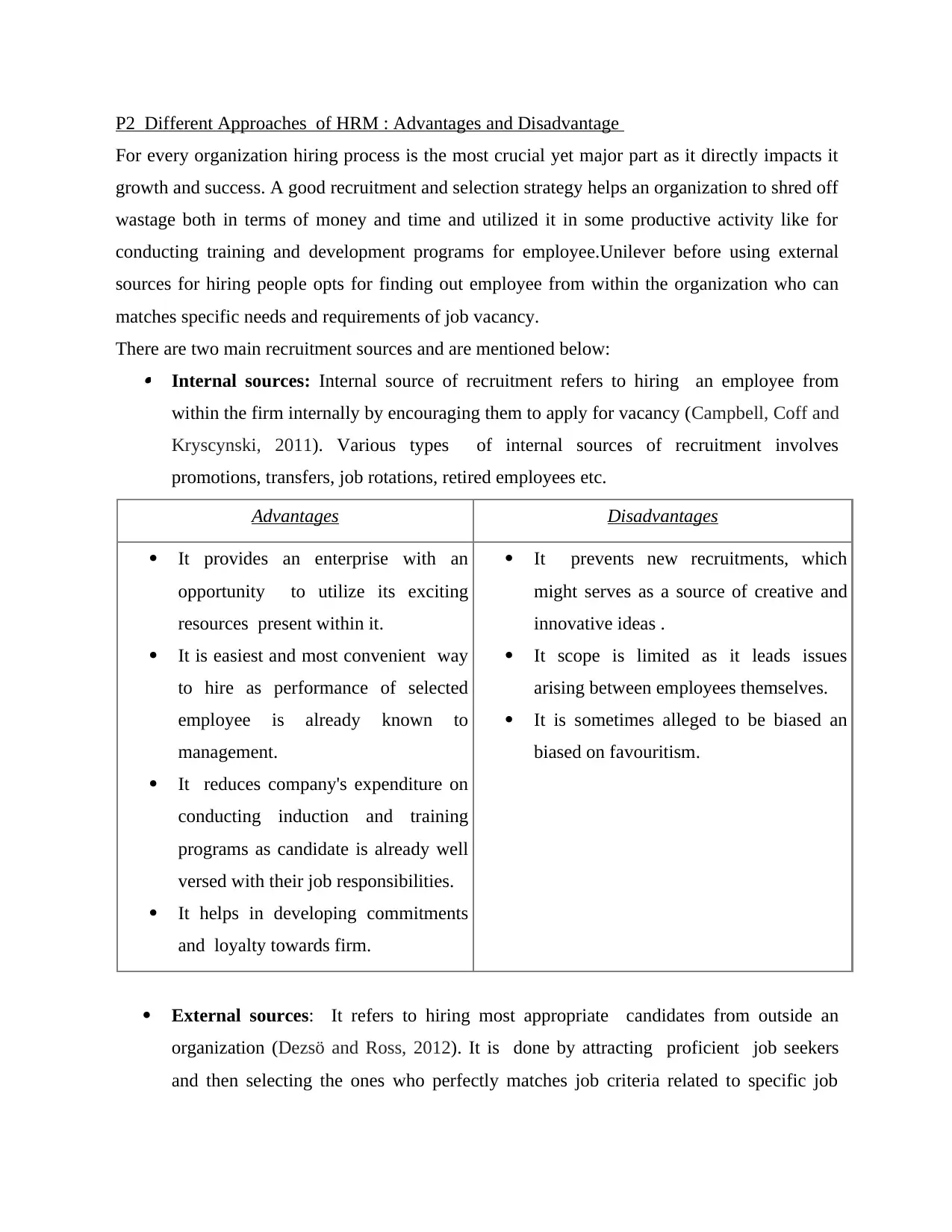
P2 Different Approaches of HRM : Advantages and Disadvantage
For every organization hiring process is the most crucial yet major part as it directly impacts it
growth and success. A good recruitment and selection strategy helps an organization to shred off
wastage both in terms of money and time and utilized it in some productive activity like for
conducting training and development programs for employee.Unilever before using external
sources for hiring people opts for finding out employee from within the organization who can
matches specific needs and requirements of job vacancy.
There are two main recruitment sources and are mentioned below: Internal sources: Internal source of recruitment refers to hiring an employee from
within the firm internally by encouraging them to apply for vacancy (Campbell, Coff and
Kryscynski, 2011). Various types of internal sources of recruitment involves
promotions, transfers, job rotations, retired employees etc.
Advantages Disadvantages
It provides an enterprise with an
opportunity to utilize its exciting
resources present within it.
It is easiest and most convenient way
to hire as performance of selected
employee is already known to
management.
It reduces company's expenditure on
conducting induction and training
programs as candidate is already well
versed with their job responsibilities.
It helps in developing commitments
and loyalty towards firm.
It prevents new recruitments, which
might serves as a source of creative and
innovative ideas .
It scope is limited as it leads issues
arising between employees themselves.
It is sometimes alleged to be biased an
biased on favouritism.
External sources: It refers to hiring most appropriate candidates from outside an
organization (Dezsö and Ross, 2012). It is done by attracting proficient job seekers
and then selecting the ones who perfectly matches job criteria related to specific job
For every organization hiring process is the most crucial yet major part as it directly impacts it
growth and success. A good recruitment and selection strategy helps an organization to shred off
wastage both in terms of money and time and utilized it in some productive activity like for
conducting training and development programs for employee.Unilever before using external
sources for hiring people opts for finding out employee from within the organization who can
matches specific needs and requirements of job vacancy.
There are two main recruitment sources and are mentioned below: Internal sources: Internal source of recruitment refers to hiring an employee from
within the firm internally by encouraging them to apply for vacancy (Campbell, Coff and
Kryscynski, 2011). Various types of internal sources of recruitment involves
promotions, transfers, job rotations, retired employees etc.
Advantages Disadvantages
It provides an enterprise with an
opportunity to utilize its exciting
resources present within it.
It is easiest and most convenient way
to hire as performance of selected
employee is already known to
management.
It reduces company's expenditure on
conducting induction and training
programs as candidate is already well
versed with their job responsibilities.
It helps in developing commitments
and loyalty towards firm.
It prevents new recruitments, which
might serves as a source of creative and
innovative ideas .
It scope is limited as it leads issues
arising between employees themselves.
It is sometimes alleged to be biased an
biased on favouritism.
External sources: It refers to hiring most appropriate candidates from outside an
organization (Dezsö and Ross, 2012). It is done by attracting proficient job seekers
and then selecting the ones who perfectly matches job criteria related to specific job
⊘ This is a preview!⊘
Do you want full access?
Subscribe today to unlock all pages.

Trusted by 1+ million students worldwide
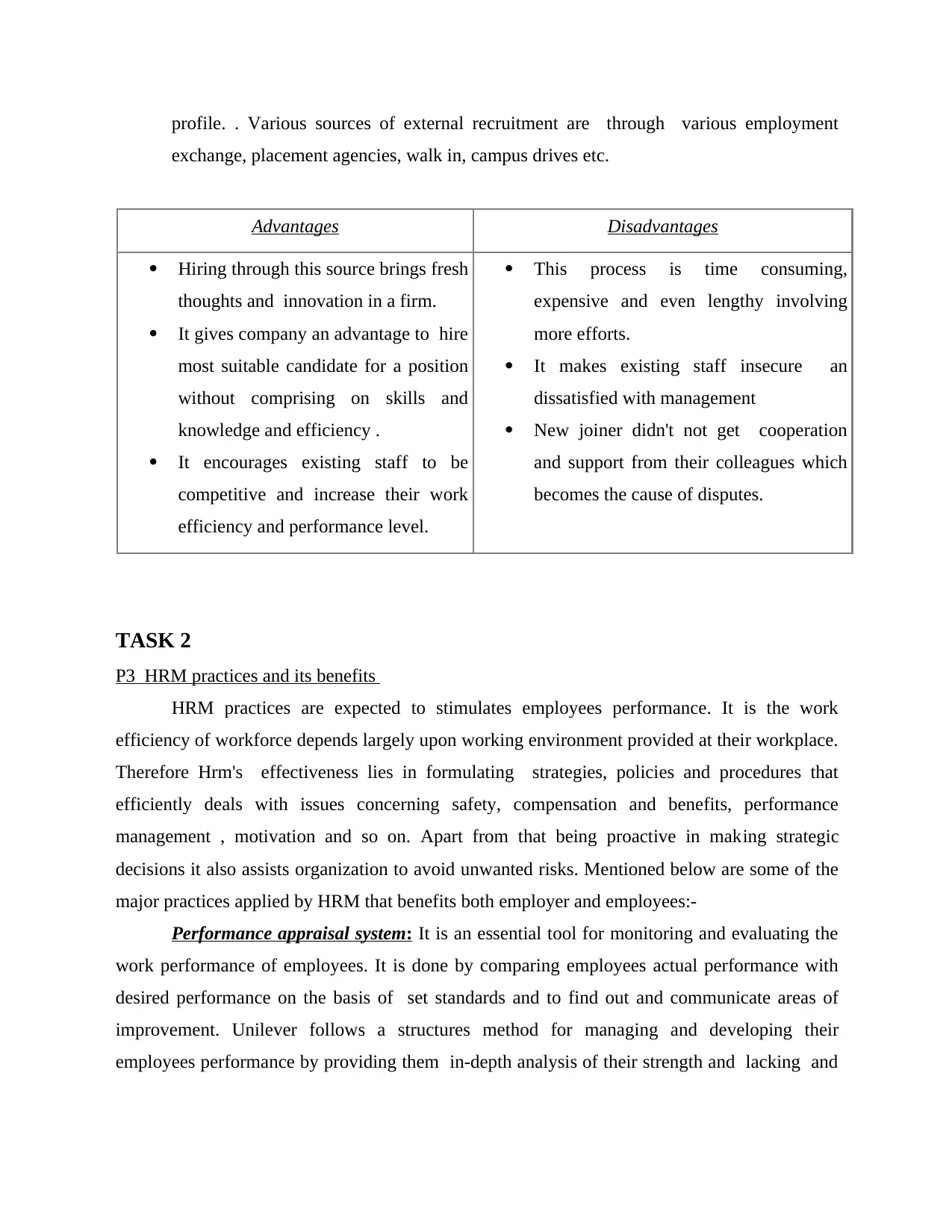
profile. . Various sources of external recruitment are through various employment
exchange, placement agencies, walk in, campus drives etc.
Advantages Disadvantages
Hiring through this source brings fresh
thoughts and innovation in a firm.
It gives company an advantage to hire
most suitable candidate for a position
without comprising on skills and
knowledge and efficiency .
It encourages existing staff to be
competitive and increase their work
efficiency and performance level.
This process is time consuming,
expensive and even lengthy involving
more efforts.
It makes existing staff insecure an
dissatisfied with management
New joiner didn't not get cooperation
and support from their colleagues which
becomes the cause of disputes.
TASK 2
P3 HRM practices and its benefits
HRM practices are expected to stimulates employees performance. It is the work
efficiency of workforce depends largely upon working environment provided at their workplace.
Therefore Hrm's effectiveness lies in formulating strategies, policies and procedures that
efficiently deals with issues concerning safety, compensation and benefits, performance
management , motivation and so on. Apart from that being proactive in making strategic
decisions it also assists organization to avoid unwanted risks. Mentioned below are some of the
major practices applied by HRM that benefits both employer and employees:-
Performance appraisal system: It is an essential tool for monitoring and evaluating the
work performance of employees. It is done by comparing employees actual performance with
desired performance on the basis of set standards and to find out and communicate areas of
improvement. Unilever follows a structures method for managing and developing their
employees performance by providing them in-depth analysis of their strength and lacking and
exchange, placement agencies, walk in, campus drives etc.
Advantages Disadvantages
Hiring through this source brings fresh
thoughts and innovation in a firm.
It gives company an advantage to hire
most suitable candidate for a position
without comprising on skills and
knowledge and efficiency .
It encourages existing staff to be
competitive and increase their work
efficiency and performance level.
This process is time consuming,
expensive and even lengthy involving
more efforts.
It makes existing staff insecure an
dissatisfied with management
New joiner didn't not get cooperation
and support from their colleagues which
becomes the cause of disputes.
TASK 2
P3 HRM practices and its benefits
HRM practices are expected to stimulates employees performance. It is the work
efficiency of workforce depends largely upon working environment provided at their workplace.
Therefore Hrm's effectiveness lies in formulating strategies, policies and procedures that
efficiently deals with issues concerning safety, compensation and benefits, performance
management , motivation and so on. Apart from that being proactive in making strategic
decisions it also assists organization to avoid unwanted risks. Mentioned below are some of the
major practices applied by HRM that benefits both employer and employees:-
Performance appraisal system: It is an essential tool for monitoring and evaluating the
work performance of employees. It is done by comparing employees actual performance with
desired performance on the basis of set standards and to find out and communicate areas of
improvement. Unilever follows a structures method for managing and developing their
employees performance by providing them in-depth analysis of their strength and lacking and
Paraphrase This Document
Need a fresh take? Get an instant paraphrase of this document with our AI Paraphraser
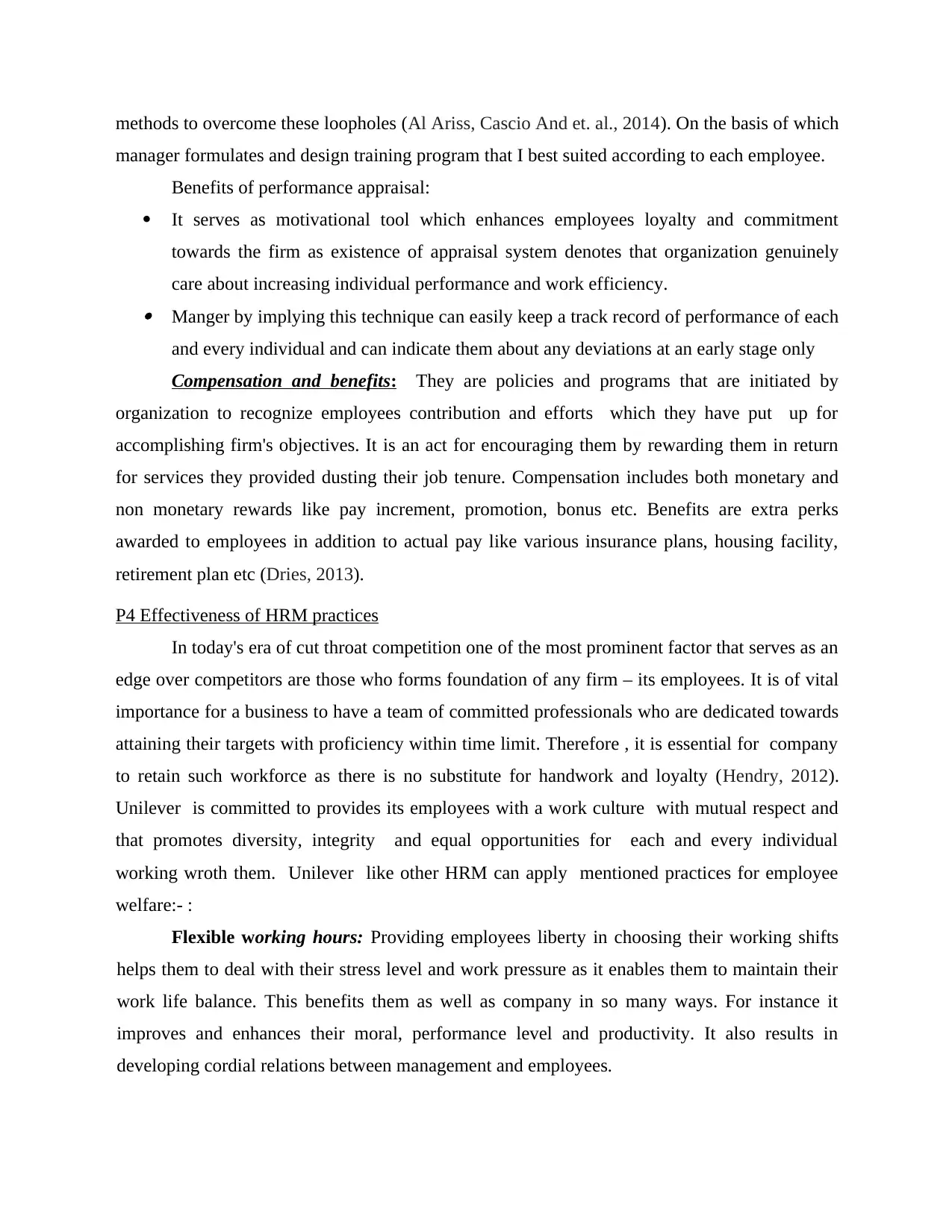
methods to overcome these loopholes (Al Ariss, Cascio And et. al., 2014). On the basis of which
manager formulates and design training program that I best suited according to each employee.
Benefits of performance appraisal:
It serves as motivational tool which enhances employees loyalty and commitment
towards the firm as existence of appraisal system denotes that organization genuinely
care about increasing individual performance and work efficiency. Manger by implying this technique can easily keep a track record of performance of each
and every individual and can indicate them about any deviations at an early stage only
Compensation and benefits: They are policies and programs that are initiated by
organization to recognize employees contribution and efforts which they have put up for
accomplishing firm's objectives. It is an act for encouraging them by rewarding them in return
for services they provided dusting their job tenure. Compensation includes both monetary and
non monetary rewards like pay increment, promotion, bonus etc. Benefits are extra perks
awarded to employees in addition to actual pay like various insurance plans, housing facility,
retirement plan etc (Dries, 2013).
P4 Effectiveness of HRM practices
In today's era of cut throat competition one of the most prominent factor that serves as an
edge over competitors are those who forms foundation of any firm – its employees. It is of vital
importance for a business to have a team of committed professionals who are dedicated towards
attaining their targets with proficiency within time limit. Therefore , it is essential for company
to retain such workforce as there is no substitute for handwork and loyalty (Hendry, 2012).
Unilever is committed to provides its employees with a work culture with mutual respect and
that promotes diversity, integrity and equal opportunities for each and every individual
working wroth them. Unilever like other HRM can apply mentioned practices for employee
welfare:- :
Flexible working hours: Providing employees liberty in choosing their working shifts
helps them to deal with their stress level and work pressure as it enables them to maintain their
work life balance. This benefits them as well as company in so many ways. For instance it
improves and enhances their moral, performance level and productivity. It also results in
developing cordial relations between management and employees.
manager formulates and design training program that I best suited according to each employee.
Benefits of performance appraisal:
It serves as motivational tool which enhances employees loyalty and commitment
towards the firm as existence of appraisal system denotes that organization genuinely
care about increasing individual performance and work efficiency. Manger by implying this technique can easily keep a track record of performance of each
and every individual and can indicate them about any deviations at an early stage only
Compensation and benefits: They are policies and programs that are initiated by
organization to recognize employees contribution and efforts which they have put up for
accomplishing firm's objectives. It is an act for encouraging them by rewarding them in return
for services they provided dusting their job tenure. Compensation includes both monetary and
non monetary rewards like pay increment, promotion, bonus etc. Benefits are extra perks
awarded to employees in addition to actual pay like various insurance plans, housing facility,
retirement plan etc (Dries, 2013).
P4 Effectiveness of HRM practices
In today's era of cut throat competition one of the most prominent factor that serves as an
edge over competitors are those who forms foundation of any firm – its employees. It is of vital
importance for a business to have a team of committed professionals who are dedicated towards
attaining their targets with proficiency within time limit. Therefore , it is essential for company
to retain such workforce as there is no substitute for handwork and loyalty (Hendry, 2012).
Unilever is committed to provides its employees with a work culture with mutual respect and
that promotes diversity, integrity and equal opportunities for each and every individual
working wroth them. Unilever like other HRM can apply mentioned practices for employee
welfare:- :
Flexible working hours: Providing employees liberty in choosing their working shifts
helps them to deal with their stress level and work pressure as it enables them to maintain their
work life balance. This benefits them as well as company in so many ways. For instance it
improves and enhances their moral, performance level and productivity. It also results in
developing cordial relations between management and employees.
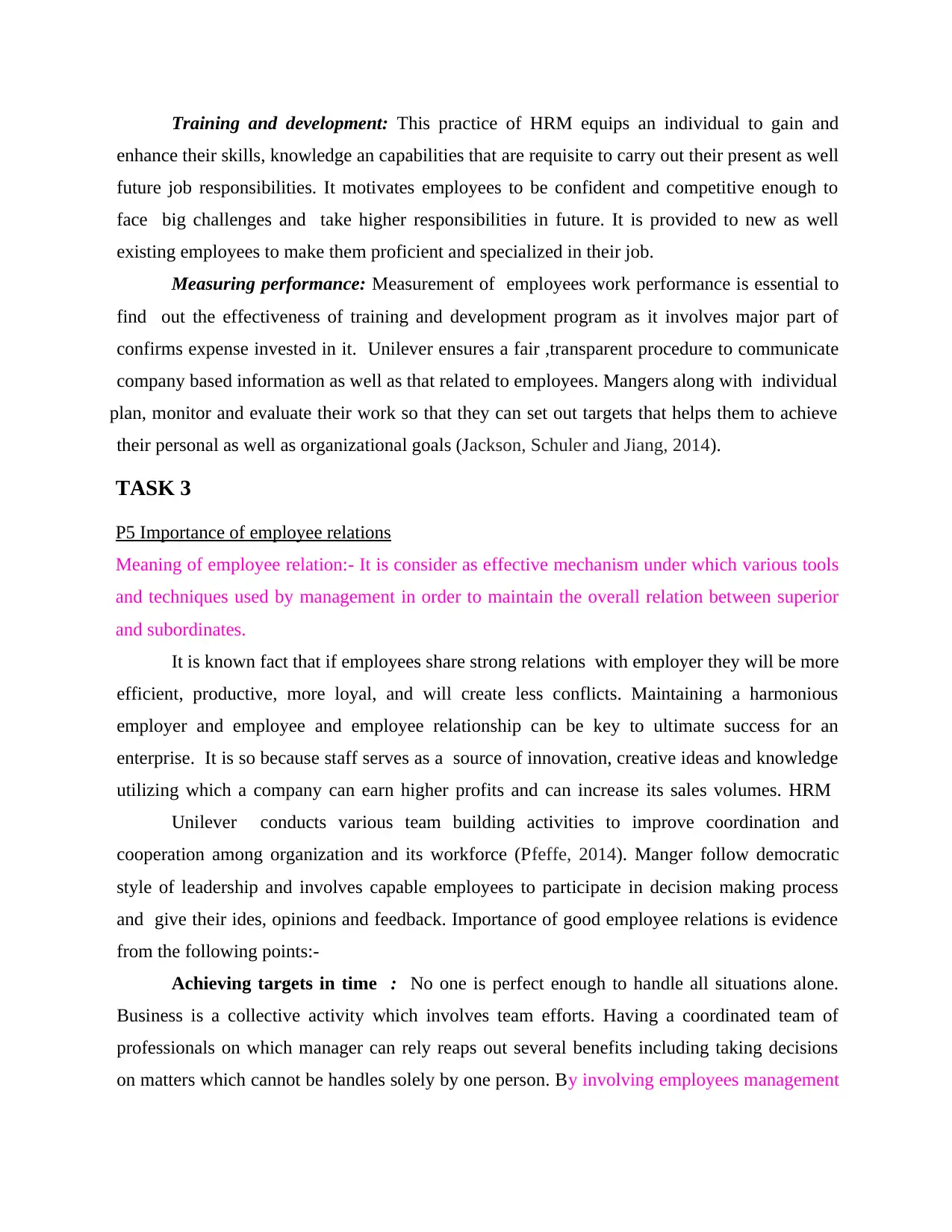
Training and development: This practice of HRM equips an individual to gain and
enhance their skills, knowledge an capabilities that are requisite to carry out their present as well
future job responsibilities. It motivates employees to be confident and competitive enough to
face big challenges and take higher responsibilities in future. It is provided to new as well
existing employees to make them proficient and specialized in their job.
Measuring performance: Measurement of employees work performance is essential to
find out the effectiveness of training and development program as it involves major part of
confirms expense invested in it. Unilever ensures a fair ,transparent procedure to communicate
company based information as well as that related to employees. Mangers along with individual
plan, monitor and evaluate their work so that they can set out targets that helps them to achieve
their personal as well as organizational goals (Jackson, Schuler and Jiang, 2014).
TASK 3
P5 Importance of employee relations
Meaning of employee relation:- It is consider as effective mechanism under which various tools
and techniques used by management in order to maintain the overall relation between superior
and subordinates.
It is known fact that if employees share strong relations with employer they will be more
efficient, productive, more loyal, and will create less conflicts. Maintaining a harmonious
employer and employee and employee relationship can be key to ultimate success for an
enterprise. It is so because staff serves as a source of innovation, creative ideas and knowledge
utilizing which a company can earn higher profits and can increase its sales volumes. HRM
Unilever conducts various team building activities to improve coordination and
cooperation among organization and its workforce (Pfeffe, 2014). Manger follow democratic
style of leadership and involves capable employees to participate in decision making process
and give their ides, opinions and feedback. Importance of good employee relations is evidence
from the following points:-
Achieving targets in time : No one is perfect enough to handle all situations alone.
Business is a collective activity which involves team efforts. Having a coordinated team of
professionals on which manager can rely reaps out several benefits including taking decisions
on matters which cannot be handles solely by one person. By involving employees management
enhance their skills, knowledge an capabilities that are requisite to carry out their present as well
future job responsibilities. It motivates employees to be confident and competitive enough to
face big challenges and take higher responsibilities in future. It is provided to new as well
existing employees to make them proficient and specialized in their job.
Measuring performance: Measurement of employees work performance is essential to
find out the effectiveness of training and development program as it involves major part of
confirms expense invested in it. Unilever ensures a fair ,transparent procedure to communicate
company based information as well as that related to employees. Mangers along with individual
plan, monitor and evaluate their work so that they can set out targets that helps them to achieve
their personal as well as organizational goals (Jackson, Schuler and Jiang, 2014).
TASK 3
P5 Importance of employee relations
Meaning of employee relation:- It is consider as effective mechanism under which various tools
and techniques used by management in order to maintain the overall relation between superior
and subordinates.
It is known fact that if employees share strong relations with employer they will be more
efficient, productive, more loyal, and will create less conflicts. Maintaining a harmonious
employer and employee and employee relationship can be key to ultimate success for an
enterprise. It is so because staff serves as a source of innovation, creative ideas and knowledge
utilizing which a company can earn higher profits and can increase its sales volumes. HRM
Unilever conducts various team building activities to improve coordination and
cooperation among organization and its workforce (Pfeffe, 2014). Manger follow democratic
style of leadership and involves capable employees to participate in decision making process
and give their ides, opinions and feedback. Importance of good employee relations is evidence
from the following points:-
Achieving targets in time : No one is perfect enough to handle all situations alone.
Business is a collective activity which involves team efforts. Having a coordinated team of
professionals on which manager can rely reaps out several benefits including taking decisions
on matters which cannot be handles solely by one person. By involving employees management
⊘ This is a preview!⊘
Do you want full access?
Subscribe today to unlock all pages.

Trusted by 1+ million students worldwide
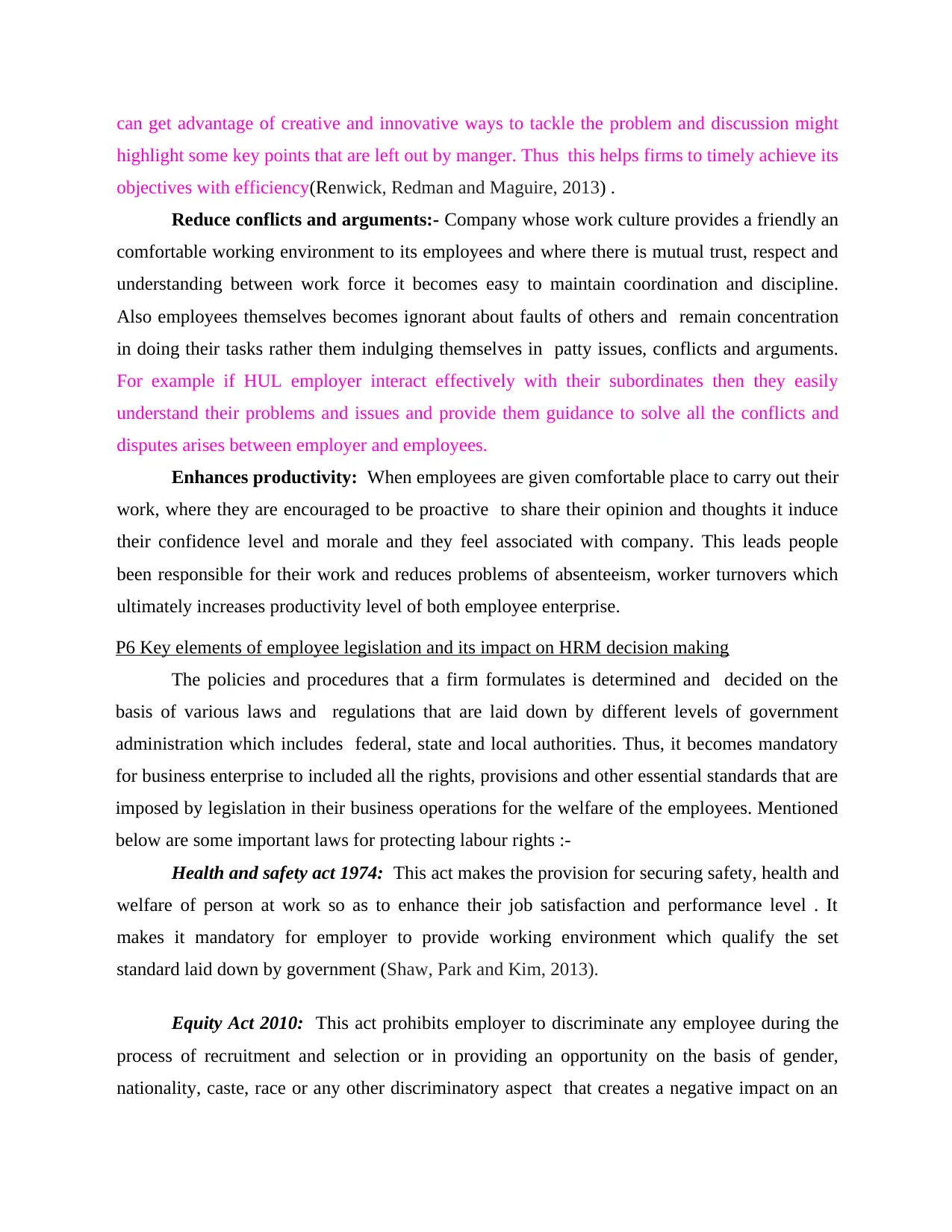
can get advantage of creative and innovative ways to tackle the problem and discussion might
highlight some key points that are left out by manger. Thus this helps firms to timely achieve its
objectives with efficiency(Renwick, Redman and Maguire, 2013) .
Reduce conflicts and arguments:- Company whose work culture provides a friendly an
comfortable working environment to its employees and where there is mutual trust, respect and
understanding between work force it becomes easy to maintain coordination and discipline.
Also employees themselves becomes ignorant about faults of others and remain concentration
in doing their tasks rather them indulging themselves in patty issues, conflicts and arguments.
For example if HUL employer interact effectively with their subordinates then they easily
understand their problems and issues and provide them guidance to solve all the conflicts and
disputes arises between employer and employees.
Enhances productivity: When employees are given comfortable place to carry out their
work, where they are encouraged to be proactive to share their opinion and thoughts it induce
their confidence level and morale and they feel associated with company. This leads people
been responsible for their work and reduces problems of absenteeism, worker turnovers which
ultimately increases productivity level of both employee enterprise.
P6 Key elements of employee legislation and its impact on HRM decision making
The policies and procedures that a firm formulates is determined and decided on the
basis of various laws and regulations that are laid down by different levels of government
administration which includes federal, state and local authorities. Thus, it becomes mandatory
for business enterprise to included all the rights, provisions and other essential standards that are
imposed by legislation in their business operations for the welfare of the employees. Mentioned
below are some important laws for protecting labour rights :-
Health and safety act 1974: This act makes the provision for securing safety, health and
welfare of person at work so as to enhance their job satisfaction and performance level . It
makes it mandatory for employer to provide working environment which qualify the set
standard laid down by government (Shaw, Park and Kim, 2013).
Equity Act 2010: This act prohibits employer to discriminate any employee during the
process of recruitment and selection or in providing an opportunity on the basis of gender,
nationality, caste, race or any other discriminatory aspect that creates a negative impact on an
highlight some key points that are left out by manger. Thus this helps firms to timely achieve its
objectives with efficiency(Renwick, Redman and Maguire, 2013) .
Reduce conflicts and arguments:- Company whose work culture provides a friendly an
comfortable working environment to its employees and where there is mutual trust, respect and
understanding between work force it becomes easy to maintain coordination and discipline.
Also employees themselves becomes ignorant about faults of others and remain concentration
in doing their tasks rather them indulging themselves in patty issues, conflicts and arguments.
For example if HUL employer interact effectively with their subordinates then they easily
understand their problems and issues and provide them guidance to solve all the conflicts and
disputes arises between employer and employees.
Enhances productivity: When employees are given comfortable place to carry out their
work, where they are encouraged to be proactive to share their opinion and thoughts it induce
their confidence level and morale and they feel associated with company. This leads people
been responsible for their work and reduces problems of absenteeism, worker turnovers which
ultimately increases productivity level of both employee enterprise.
P6 Key elements of employee legislation and its impact on HRM decision making
The policies and procedures that a firm formulates is determined and decided on the
basis of various laws and regulations that are laid down by different levels of government
administration which includes federal, state and local authorities. Thus, it becomes mandatory
for business enterprise to included all the rights, provisions and other essential standards that are
imposed by legislation in their business operations for the welfare of the employees. Mentioned
below are some important laws for protecting labour rights :-
Health and safety act 1974: This act makes the provision for securing safety, health and
welfare of person at work so as to enhance their job satisfaction and performance level . It
makes it mandatory for employer to provide working environment which qualify the set
standard laid down by government (Shaw, Park and Kim, 2013).
Equity Act 2010: This act prohibits employer to discriminate any employee during the
process of recruitment and selection or in providing an opportunity on the basis of gender,
nationality, caste, race or any other discriminatory aspect that creates a negative impact on an
Paraphrase This Document
Need a fresh take? Get an instant paraphrase of this document with our AI Paraphraser
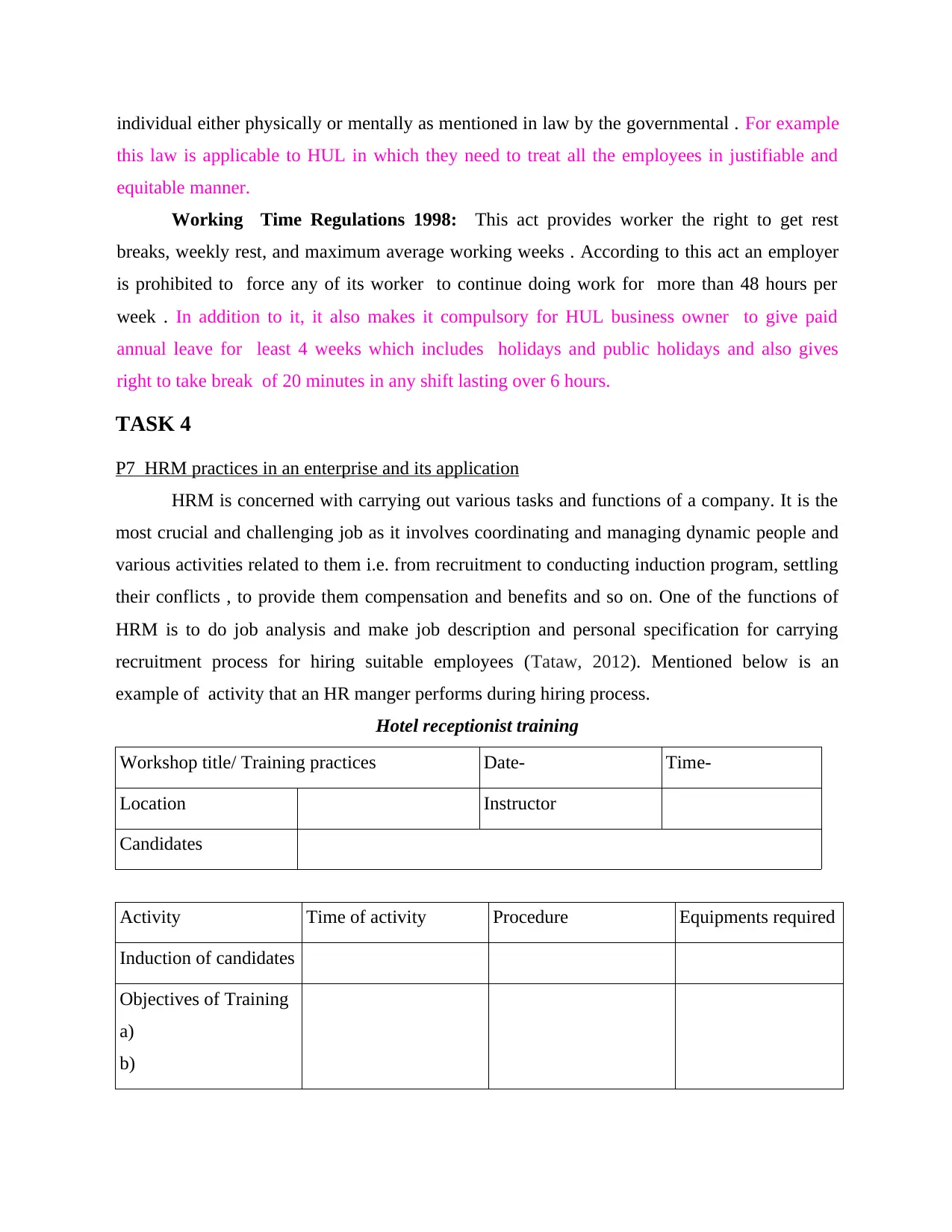
individual either physically or mentally as mentioned in law by the governmental . For example
this law is applicable to HUL in which they need to treat all the employees in justifiable and
equitable manner.
Working Time Regulations 1998: This act provides worker the right to get rest
breaks, weekly rest, and maximum average working weeks . According to this act an employer
is prohibited to force any of its worker to continue doing work for more than 48 hours per
week . In addition to it, it also makes it compulsory for HUL business owner to give paid
annual leave for least 4 weeks which includes holidays and public holidays and also gives
right to take break of 20 minutes in any shift lasting over 6 hours.
TASK 4
P7 HRM practices in an enterprise and its application
HRM is concerned with carrying out various tasks and functions of a company. It is the
most crucial and challenging job as it involves coordinating and managing dynamic people and
various activities related to them i.e. from recruitment to conducting induction program, settling
their conflicts , to provide them compensation and benefits and so on. One of the functions of
HRM is to do job analysis and make job description and personal specification for carrying
recruitment process for hiring suitable employees (Tataw, 2012). Mentioned below is an
example of activity that an HR manger performs during hiring process.
Hotel receptionist training
Workshop title/ Training practices Date- Time-
Location Instructor
Candidates
Activity Time of activity Procedure Equipments required
Induction of candidates
Objectives of Training
a)
b)
this law is applicable to HUL in which they need to treat all the employees in justifiable and
equitable manner.
Working Time Regulations 1998: This act provides worker the right to get rest
breaks, weekly rest, and maximum average working weeks . According to this act an employer
is prohibited to force any of its worker to continue doing work for more than 48 hours per
week . In addition to it, it also makes it compulsory for HUL business owner to give paid
annual leave for least 4 weeks which includes holidays and public holidays and also gives
right to take break of 20 minutes in any shift lasting over 6 hours.
TASK 4
P7 HRM practices in an enterprise and its application
HRM is concerned with carrying out various tasks and functions of a company. It is the
most crucial and challenging job as it involves coordinating and managing dynamic people and
various activities related to them i.e. from recruitment to conducting induction program, settling
their conflicts , to provide them compensation and benefits and so on. One of the functions of
HRM is to do job analysis and make job description and personal specification for carrying
recruitment process for hiring suitable employees (Tataw, 2012). Mentioned below is an
example of activity that an HR manger performs during hiring process.
Hotel receptionist training
Workshop title/ Training practices Date- Time-
Location Instructor
Candidates
Activity Time of activity Procedure Equipments required
Induction of candidates
Objectives of Training
a)
b)
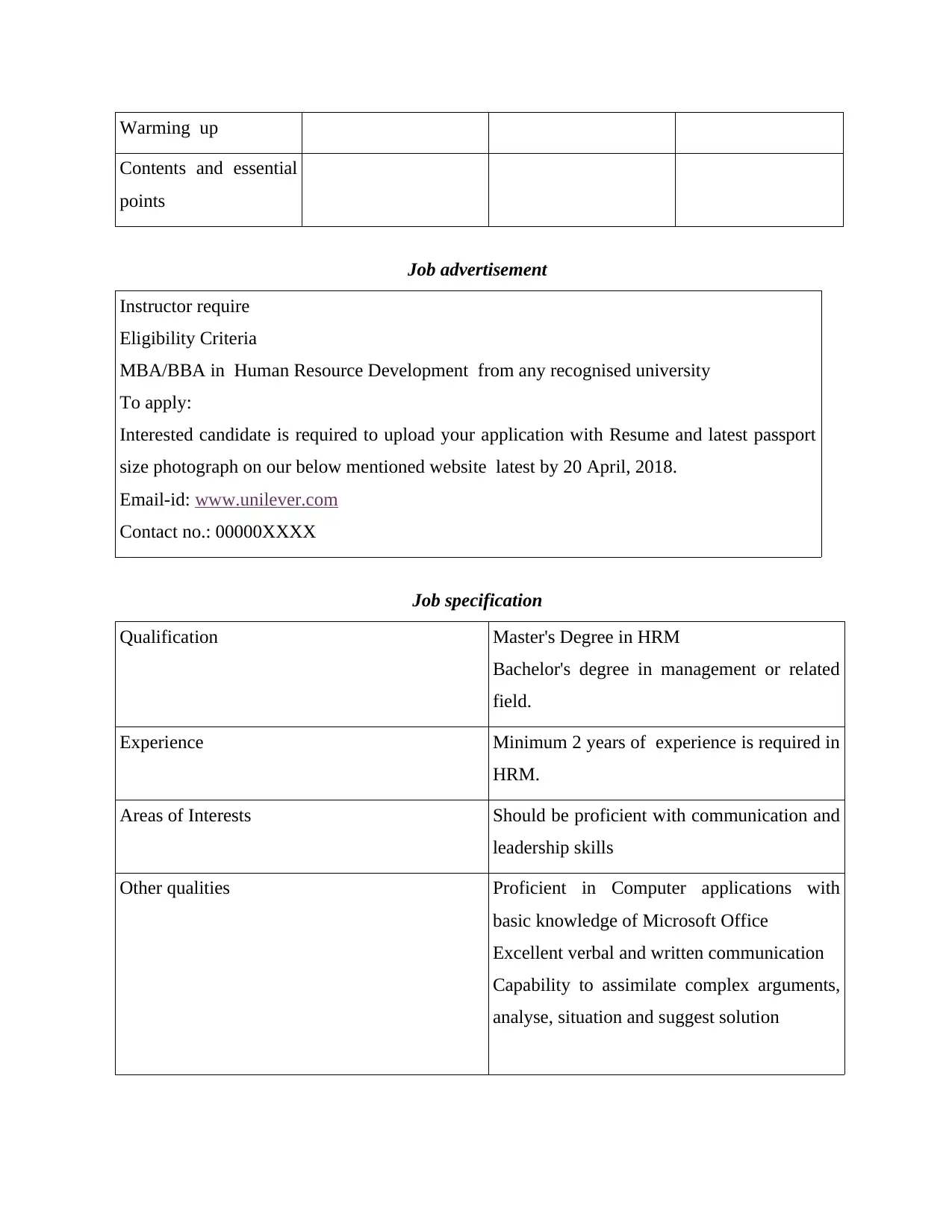
Warming up
Contents and essential
points
Job advertisement
Instructor require
Eligibility Criteria
MBA/BBA in Human Resource Development from any recognised university
To apply:
Interested candidate is required to upload your application with Resume and latest passport
size photograph on our below mentioned website latest by 20 April, 2018.
Email-id: www.unilever.com
Contact no.: 00000XXXX
Job specification
Qualification Master's Degree in HRM
Bachelor's degree in management or related
field.
Experience Minimum 2 years of experience is required in
HRM.
Areas of Interests Should be proficient with communication and
leadership skills
Other qualities Proficient in Computer applications with
basic knowledge of Microsoft Office
Excellent verbal and written communication
Capability to assimilate complex arguments,
analyse, situation and suggest solution
Contents and essential
points
Job advertisement
Instructor require
Eligibility Criteria
MBA/BBA in Human Resource Development from any recognised university
To apply:
Interested candidate is required to upload your application with Resume and latest passport
size photograph on our below mentioned website latest by 20 April, 2018.
Email-id: www.unilever.com
Contact no.: 00000XXXX
Job specification
Qualification Master's Degree in HRM
Bachelor's degree in management or related
field.
Experience Minimum 2 years of experience is required in
HRM.
Areas of Interests Should be proficient with communication and
leadership skills
Other qualities Proficient in Computer applications with
basic knowledge of Microsoft Office
Excellent verbal and written communication
Capability to assimilate complex arguments,
analyse, situation and suggest solution
⊘ This is a preview!⊘
Do you want full access?
Subscribe today to unlock all pages.

Trusted by 1+ million students worldwide
1 out of 16
Related Documents
Your All-in-One AI-Powered Toolkit for Academic Success.
+13062052269
info@desklib.com
Available 24*7 on WhatsApp / Email
![[object Object]](/_next/static/media/star-bottom.7253800d.svg)
Unlock your academic potential
Copyright © 2020–2025 A2Z Services. All Rights Reserved. Developed and managed by ZUCOL.





